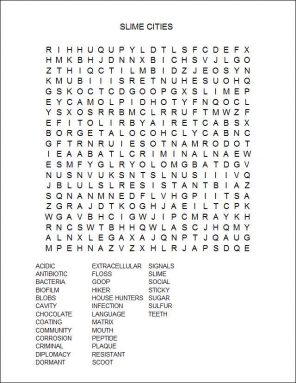Slime cities
Bacteria living in tiny ‘cities,’ called biofilms, can rot teeth or rust metal
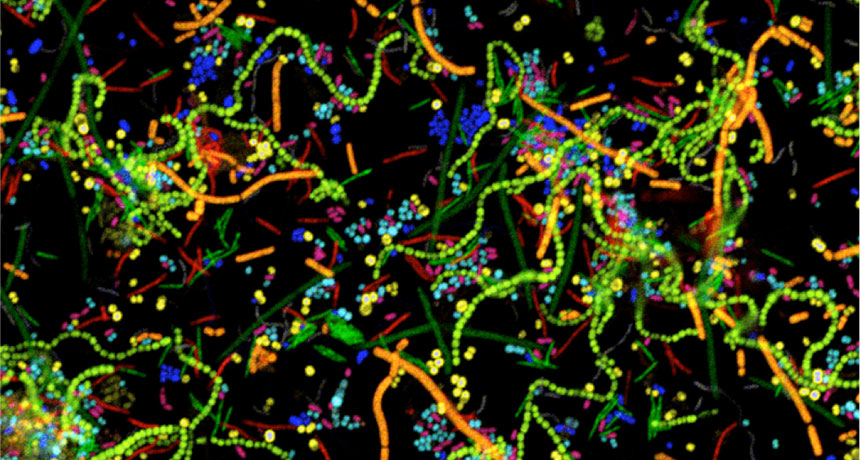
Biofilms are home to many different types of bacteria, including the 15 varieties shown here. To make the tiny organisms easier to see, scientists zoomed in using a microscope and colored each microbe a different hue.
Alex Valm and Gary Borisy
Tiny blobs of slime cover your teeth. They also lurk inside your body, on the walls of swimming pools and on boats in the ocean. Sometimes they even grow on the smooth surfaces of medical devices. These slimes are called biofilms. They’re like miniature cities. Each one can house tens of millions of bacteria. All these bacteria need to grow are food and water. And food for these tiny microbes could be anything from sugar to sewage.
As gross as they sound, these slime cities often prove helpful. Without bacteria and biofilms, we’d be wading through piles of garbage: These tiny microbes love to eat human and animal wastes. And most biofilms inside the body promote health. Many have been with you since birth. When good biofilms flourish, they leave little room for bad germs to move in.
Stephen Dexter calls biofilms “one of the wonders of the environmental system on Earth.” An engineer at the University of Delaware in Newark, he studies how biofilms and seawater affect materials.
But biofilms can be harmful, hosting large populations of disease-causing germs. Others rust through pipes, boat hulls and other important equipment. And biofilms are especially dangerous when they grow on medical equipment. For example, a heart surgeon may put a device called a pacemaker inside someone’s heart to regulate its beating. If a biofilm forms on that device, it could nurture germs capable of spawning a deadly infection.
How can researchers wage war against these slime dwellers? First, they can try to set up barriers to halt their growth. Second, they can target medicines or chemicals against biofilms that are already in place. And lately, some researchers have been learning how to “talk” to bacteria inside a biofilm. If they can learn the microbes’ language, they might recruit only good guys to settle into a slime city.
A mouthful of bugs
Bacteria do not always live in groups. Individuals may swim inside your mouth or some other moist environment. On its own, a germ is like a person hiking alone through the woods. The hiker has to carry or catch her own food and scout for danger. But most bacteria, like most people, prefer the social life. Humans tend to live in communities. Many germs similarly settle into united groups of species. “Bacteria normally live as part of a community. With their friends, they do much better,” notes Floyd Dewhirst. He works at the Forsyth Institute in Boston, Mass. This research group focuses on dental health.

Of course, cities of bacteria can’t erect actual buildings. Instead, they extend little hairs called pili and use them to grab onto a surface. Then, they produce a sticky, slimy net called an extracellular matrix. It holds the biofilm together and helps fortify it. Inside, many species live together. Each has a special job. By working as a team, they keep the biofilm strong.
But house-hunting bacteria won’t just settle anywhere. They scout for good spots, such as the inside of your mouth. Teeth and gums provide solid surfaces on which they can build. And food flows to them every time you eat or drink. “They grab some of the sugar or nutrients as they come by and it helps them grow,” explains Dewhirst. Sugary soft drinks and chocolate bars are among their favorite treats!
If you forget to brush your teeth for a day or two, a thick, slippery layer will build up on your teeth. If you scrape it off with your fingernail, it will appear as a whitish goop. This is what dentists call plaque (PLAK). One tiny dab may contain millions or even billions of bacteria.
Microbes that live in the mouth come in many shapes and sizes. Some are rod-shaped. Others look like spheres or springs. A healthy mouth contains about 200 different species. Most of these germs are law-abiding citizens. They go about their business without triggering sickness or pain. But a few bugs are baddies.
One common troublemaker is Streptococcus mutans (STREP-tow-KOK-us MEW-tans). It feasts on sugar and produces lactic acid. This acid, also found in milk, is strong enough to dissolve the mineral that makes up your teeth.
A small population of Streptococcus mutans (S. mutans, for short) is nothing to worry about: Every city in the world has a few criminals. They don’t make the entire city a bad place to live. However, if crime increases, good people will start to move out. The same kind of thing can happen inside your mouth. If you drink too many soft drinks or don’t brush, then S. mutans can grow out of control. It can produce so much acid that other bacteria die off. As those species die, S. mutans gains more room to set up its own neighborhoods from which to spew even more acid.
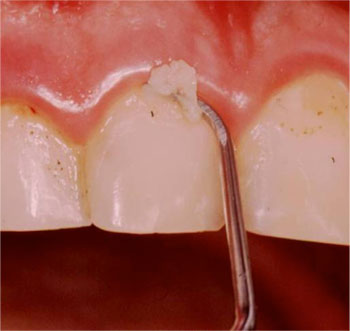
Slime warfare
Biofilms don’t stop at your mouth. They also grow elsewhere inside the body. “You’re actually more bacteria than person,” explains George O’Toole, of Dartmouth Medical School in Hanover, N.H. As a microbiologist, he studies microbes and how they interact with their surroundings.
Biofilms that grow out of control can cause disease. For example, some kids have harmful biofilms growing inside their ears. When these cities flourish into giant metropolises, the ears become infected. Dangerous biofilms also may grow inside the lungs and cause pneumonia. This can provoke serious coughs, fever and trouble breathing. In healthy people, the body can usually keep germs in check. But people who already are weak or sick may become gravely ill.
Doctors often prescribe drugs called antibiotics to fight bacterial infections. But once the bugs have settled inside a biofilm, these germs can become up to 1,000 times more resistant to antibiotics than when they are living as individual cells, says O’Toole. One reason: That slime can shield a biofilm’s inhabitants from the killer drugs.
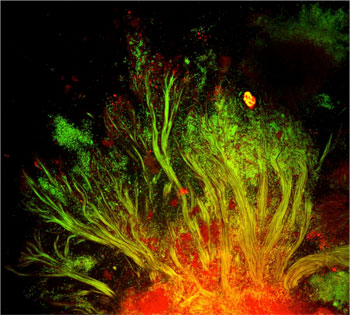
Even worse, these survivors may learn how to resist the antibiotic in the future. Next time, that medicine may have no effect.
Chomping through metal
Biofilms wreak havoc outside of the body, too. When slime builds up in your fish tank or a hole rusts through the hull of a boat, biofilms may be to blame. Some biofilms can eat away a metal surface, making it rusty and brittle. They can help form holes that may break through steel over a span of months or years. This process is called corrosion.
Metal wears out over time even without any bacteria around. For example, seawater naturally contains chemicals that cause corrosion. But certain microbes can speed up this process. “They form a mound of slime and rust,” says Dexter at Delaware. This mound isolates a spot that is corroding from the rest of the environment.
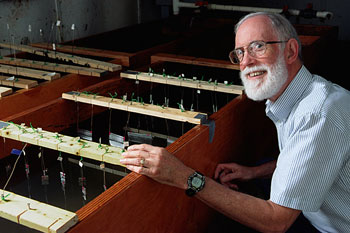
Corrosive biofilms may be tiny, but they can have a huge impact. Randall Irvin is a microbiologist at Canada’s University of Alberta in Edmonton. He recalls a story about biofilm damage from when he was in graduate school. A nearby gas plant called Irvin’s professor to say that it had lost a whole dump truck. (No, the bugs hadn’t swallowed up the truck!)
The gas plant had stored piles of sulfur outdoors. Over time, microbes converted some of it into sulfuric acid. That acid leaked into the ground around the plant. This corroded a metal water pipe under a road. Later, the buried pipe collapsed as the truck drove across the road, bringing it down too. Irvin’s professor told the gas company that it had to do a better job storing its sulfur.
Such problems happen often. Industries have to spend billions of dollars each year to replace or fix corroded or rusty metal. Often biofilms caused the damage or at least made it worse.
Game-changing tactics
Researchers are looking at several different ways to combat or control worrisome biofilms. These include barriers so that biofilms can’t attach and grow. Irvin and his colleagues at a Canadian biotechnology company, Arch Biopartners in Toronto, have developed a special coating. They call it Borg peptide. When they coat it onto metal or plastic, it helps prevent biofilms from developing. Fewer than half as many biofilms form on a surface coated with this chemical, their studies show.
Borg peptide works by making it difficult for bacteria to attach. To a tiny germ, a smooth plastic surface isn’t smooth at all. It actually is full of places to grab onto, like rungs on the monkey bars at a playground. The microbes use their pili to hang on and swing along like a kid playing on those monkey bars, explains Irvin. The peptide acts like a bully who won’t let anyone else play. It basically holds onto all of the rungs. Now, bacteria looking for a rung to grab are out of luck.
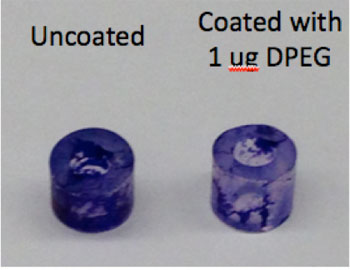
Another way to keep bad germs from moving into a neighborhood: diplomacy. Species inside a slime city communicate by using touch and chemical signals. Those signals are a type of chemical language. They can recruit new residents or tell house-hunters to just keep looking.
“We’re trying to translate what [the germs are] saying, how they’re hearing it, and how they respond,” says Mary Ellen Davey. She studies microbes of the mouth at the University of Florida’s College of Dentistry in Gainesville.
If researchers could learn to speak microbes’ languages, they could use the same signals to convince bad bacteria it’s time to scoot. They also could invite good germs in to set up camp. Scientists have already managed to do this with a single kind of bacterium in a controlled laboratory setting. Such research might one day allow them to control wild biofilms living in people and in the environment.
One advantage: Today’s antibiotics target all bacteria, good and bad alike. In the future, doctors instead might send out chemical signals to rout just the one troublemaker species. For example, your dentist might give you a treatment that will oust S. mutans, but leave all the other microbes in your mouth alone. (However, you’d still have to brush and floss!)
As for microbes that cause rust and other trouble in the environment: They could eventually be put to work. Biofilms produce energy as they eat, and scientists want to harness that power to make electricity or chemicals that people need. The more scientists learn about how slime cities work and how people might control them, the less dangerous they will become. So the next time you pick a glob of plaque off your teeth, take a good look at it. Instead of saying “ewww,” say “hello” to all the bugs — good and bad — that call you home!
Power Words
(for more about Power Words, click here)
antibiotic A germ-killing substance prescribed as a medicine (or sometimes as a feed additive to promote the growth of livestock). It does not work against viruses.
bacterium (plural bacteria) A single-celled organism. These dwell nearly everywhere on Earth, from the bottom of the sea to inside animals.
biofilm A gooey community of different types of microbes that essentially glues itself to some solid surface. Living in a biofilm is one way microbes protect themselves from stressful agents (such as poisons) in their environment.
chemical signal A message made up of molecules that get sent from one place to another. Bacteria and some animals use these signals to communicate.
corrosion A process whereby metals react with gases or other materials in their environment and undergo a type of degradation. The rusting of iron, for instance, is one example of corrosion, driven by exposure to moisture.
dental cavity A tiny hole in a tooth that develops over time. Cavities are more likely to happen when a person eats a lot of sugar or does not brush and floss regularly.
diplomacy Compelling adversaries (usually different countries or warring groups) to change their attitudes, policies or actions based on discussions that make a case with logic or compromise.
dormant Inactive to the point where normal body functions are suspended or slowed down.
engineer A person who uses science to solve problems. As a verb, to engineer means to design a device, material or process that will solve some problem or unmet need.
extracellular matrix A sticky, slimy net that supports and protects the bacteria cells inside a biofilm.
germ Any one-celled microorganism, such as a bacterium, fungal species or virus particle. Some germs cause disease. Others can promote the health of higher-order organisms, including birds and mammals. The health effects of most germs, however, remain unknown.
infection A disease that can spread from one organism to another.
lactic acid A chemical compound commonly found in milk. Bacteria in your mouth also produce this acid. Too much of it can lead to tooth decay.
microbe Short for microorganism. A living thing that is too small to see with the unaided eye, including bacteria, some fungi and many other organisms such as amoebas. Most consist of a single cell.
microbiology The study of microorganisms, principally bacteria, fungi and viruses. Scientists who study microbes and the infections they can cause or ways that they can interact with their environment are known as microbiologists.
nutrients Vitamins, minerals, fats, carbohydrates and proteins needed by organisms to live, and which are extracted through the diet.
pacemaker A small medical device implanted in the body to help control abnormal heart rhythms. This device sends an electrical signal. It stimulates the heart to beat at a regular and healthy rate.
peptide A short chain of amino acids (usually fewer than 100).
pilus (plural pili) A tiny hair-like structure found on a bacterium.
plaque A biofilm, or community of bacterial species, that grows on teeth and other surfaces in the mouth.
pneumonia A lung disease in which infection by a virus or bacterium causes inflammation and tissue damage. Sometimes the lungs fill with fluid or mucus. Symptoms include fever, chills, cough and trouble breathing.
resistance (as in drug resistance) The reduction in the effectiveness of a drug to cure a disease, usually a microbial infection.
species A group of similar organisms capable of producing offspring that can survive and reproduce.
Streptococcus mutans A bacterium commonly found in the human mouth. Its growth may lead to tooth decay. The name is abbreviated as S. mutans.
sulfuric acid A strong acid having the chemical formula H2SO4. Used as a drain cleaner and in lead-acid car batteries, the liquid is able to burn tissues and eat through metals and even rock.
Word Find (click here to enlarge for printing)
